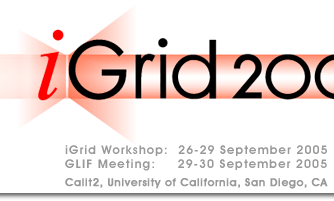News Releases
The First Stereoscopic and uncompressed HD Videoconference Using User Controlled Lightpath (UCLP) over the Big GLORIAD between Korea and USA
San Diego, CA, September 28, 2005 - KISTI (Korea Institute of Science and Technology Information), in cooperation with CANARIE, GIST, KNU, KAIST and other collaborators, demonstrated high-definition videoconferencing using compressed stereoscopic and uncompressed HD, and KISTI also demonstrated collaborative simulation of High Energy Physics. Both demonstrations were performed across the trans-pacific Big GLORIAD link that had been built with 10Gbps lambda facilities on August 1st, 2005, based on UCLP (User Controlled Lightpath), and used during September 26-29 at the iGrid 2005 conference in San Diego. Attendees were very impressed by dancing and fighting robots,in which HD streams were delivered from Daejeon, Korea to the San Diego venue in real-time, and by HDTV presentations on Korean High Energy Physics research. These demonstrations were performed as a part of CANARIE’s iGrid presentation, entitled “World’s first demonstration of X-GRID application switching using User Controlled Lightpaths.”
User Controlled Lightpath (UCLP) over GLORIAD
Research is underway to handle both the quality of Internet services and the control of network bandwidth. UCLP is one of the promising technologies, which enables users to setup and tear down their light paths on demand. UCLP is being enhanced, and it’s new release, UCLPv2, allows users to orchestrate lightpaths using web-based applications. KISTI showed how UCLP effectively controls lightpaths and thus helps network applications boost up their transmission performance for the first time over the 10Gb GLORIAD network.
Stereoscopic and Interactive Uncompressed HDTV Videoconference
The demonstration was the first attempt to send uncompressed interactive HD videoconferencing over the UCLP-enabled 10Gb GLORIAD network between Korea and USA. iGrid 2005 participants experienced high-definition images of dancing and fighting robots from Korea in real time without any degradation of viewing quality. The remote site also viewed scenes from San Diego without any quality deterioration.
Collaborative Simulation on High Energy Physics
Participants enjoyed the real-time simulation of CMS data analysis of High Energy Physics for e-Science over the high-performance GLORIAD link. KNU presented a talk about CHEP (Center of High Energy Physics), HEP over GLORIAD, and other activities with very high performance that has low jitter, no loss and minimal delay.
Collaborators :
KISTI (Korea Institute of Science and Technology Information) in Korea
CANARIE (Canada’s advanced Internet development organization) in Canada
GIST (Gwangju Institute of Science and Technology) in Korea
KNU (Kyungpuk National University) in Korea
KAIST (Korea Advanced Institute of Science and Technology) in Korea
CRC (communications Research Center Canada) in Canada
NCHC (National Center for High performance Computing) in Taiwan
i2CAT (Internet2 Catalunya) in Spain
ANF (Advanced Network Forum) in Korea
Further Information:
For more information on Korea’s challenge at iGrid 2005, contact Dongkyun Kim (mirr @ kisti.re.kr) and Jinyong Jo (jinyong.jo @ gmail.com) of the KISTI Supercomputing Center, Dajeon, Korea.


